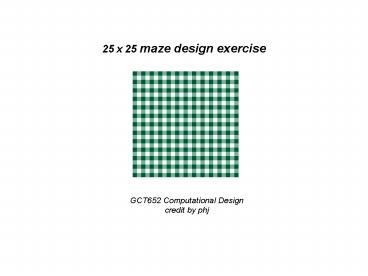25 x 25 maze design exercise - PowerPoint PPT Presentation
1 / 16
Title:
25 x 25 maze design exercise
Description:
The 'solution' of maze puzzle means the discovery of a passage to their 'goal' or 'center. ... Making various mazes from the template ... – PowerPoint PPT presentation
Number of Views:55
Avg rating:3.0/5.0
Title: 25 x 25 maze design exercise
1
25 x 25 maze design exercise
GCT652 Computational Designcredit by phj
2
maze Maze is defined as a tour puzzle in the
form of a complex branching passage through which
the solver must find a route. The solution of
maze puzzle means the discovery of a passage to
their goal or center.
3
Scientific thinking in the process of making a
maze 1) Defining a problem 2) Constructing
hypothesis 3) Developing rules from analysis 4)
Generating representations (synthesis) with the
rules 5) Finding a solution with the criteria
under a given circumstance
4
Defining Problems
If maze is too easy, then a visitor will get
bored. If it is too complex, then the visitor
will panic How do I know if my maze is easy or
difficult?
5
- Constructing Hypothesis
- Design factor(s)
- Controlling the factors, we will have the
best maze design - under a given situation.
- The length of passage consumed for
finding a maze solution - The number of
decisions made for the solution - The
width of the passage and the shape height of
the wall - The number size of openings
on the wall - Supplementary items roof,
chair, and bench
6
- Generating representations (synthesis) with rules
from analysis - Making various mazes from the template
- Reviewing the factors and changing the values
of the factors - Finding a solution with the criteria
7
TASK An interactive 25x25 Maze Design template
is accessible to you via course website. One
island within the template is the destination of
the maze. Each side of the template allows only
one entrance. Deciding the locations of the
entrances and the island are up to you. One
side of each square represents 3 feet (1 yard).
8
Develop three maze alternatives in
two-dimension. Representing the alternatives with
tree, you find out a maze design solution. Tree
representation will be your logical explanation
for your design decision as your design develops.
9
entrance
node branching point needs to be connected
more than three nodes
node turning point
passage
dead end
Goal in this case, I used a square, but the
goal area can be represented by a thick line. It
means that any shape can be applied according to
your design
10
entrance
node branching point (Difficulty Weight
10) needs to be connected more than three nodes
node turning point (Difficulty Weight 2)
Passage (Difficulty Weight 1)
dead end
Goal in this case, I used a square, but the
goal area can be represented by a thick line. It
means that any shape can be applied according to
your design
11
Using tree representation, you may measure the
difficulty of the maze according to 1) The
number of turning points 2) The number of
branching nodes 3) The length of passage that
visitors need to take to achieve a goal You
may need to consider possible minimum and maximum
length.
One side of square represents 1 yard (3
feet) Average human walking speed is 4.55
feet/sec 272.8 feet/min 90.93 yard/min
12
ENT 2
ENT 1
ENT 2
ENT 1
0 (Difficulty Weight 10)
1 (Difficulty Weight 10)
2 (Difficulty Weight 2)
0 (Difficulty Weight 2)
9 (Difficulty Weight 1)
3 (Difficulty Weight 1)
1x 10 0 x 2 3x1 13 yards 13x3 39 feet 39
/ 4.55 8.57 seconds
0x 10 2 x 2 9x1 13 yards 13x3 39 feet 39
/ 4.55 8.57 seconds
13
ENT 2
ENT 1
ENT 1 1x 10 0 x 2 3x1 13 yards 13x3 39
feet 39 / 4.55 8.57 seconds
ENT 2 0x 10 2 x 2 9x1 13 yards 13x3 39
feet 39 / 4.55 8.57 seconds
Average amount of time for solving a Maze (Sum
of the amount of time consumed for each
entrance)/ (number of Entrances) For
example, Difficulty level of this Maze (8.57
8.57)/2 8.57
14
After you select your two-dimensional design
solution from three alternatives, generate its
geometric variations with changing parametric
values of the design. The parametric values
include the angle of the corners, the width of
the passage, the length of the wall, the height
of the wall and the distance between the grids.
In addition, you may change the shape of the wall
the template, and delete/add a component
from/to your maze design. Through your design
trials and errors, you will make the physical
models of three variations of the selected maze.
15
As a result, there will be 1) Three maze
alternatives in two-dimension with tree
representations. 2) Three dimensional models of
three geometric variations of the selected maze
16
Once youve got your own maze, can you find the
shortest path? Computational approach to
search Ex) stack, queue, priority queue,
etc. Interesting issue for CS time and space































